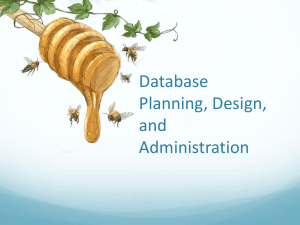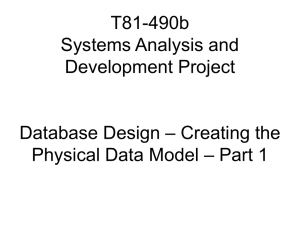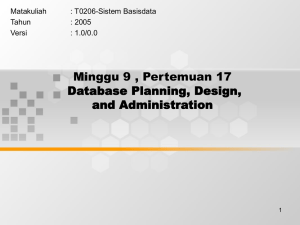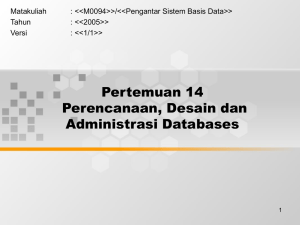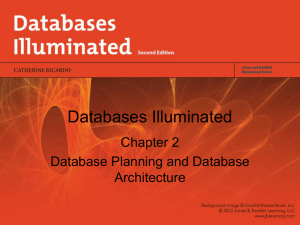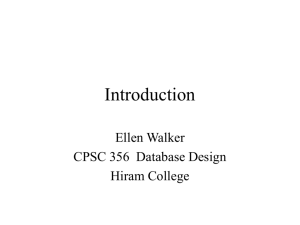Chapter 1
advertisement
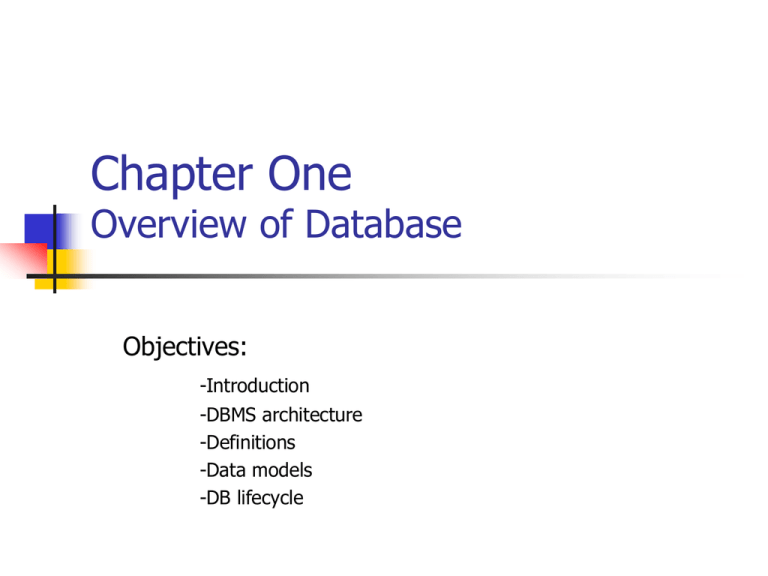
Chapter One Overview of Database Objectives: -Introduction -DBMS architecture -Definitions -Data models -DB lifecycle Definitions Database Management System (DBMS): is a record keeping system (software) that allows one or more people to use or modify the data. 2 Why DBMS: Centralized Control Redundancy(Eliminated or Reduced) (Propagating update) Inconsistency (Avoided) Shared Data Standardization Security Integrity Transaction Support Complex Design Required Specialist (DBA) Training Cost Program Failures (potential) Cost 3 Good DBMS must have: Support for at least one Data Model Support for certain high level languages for Retrieve, Insert, Deletes, etc. into Database (Navigate) Transaction Management: Capable of access to DB by many users at once Access control: Limit access to DB by unauthorized user Recovery capability form system failure Security System 4 Architecture of DBMS View Conceptual DB Physical DB View Level: Def: Example (SQL) CREATE VIEW SELECT FROM GradStudent Name, ID, GPA Students; Data Manipulation Language (DML) (Query Language) 5 Architecture of DBMS Conceptual Level: Describe what data are stored & relationship among data (DB) Example: Students=Record Name:char[15]; ID:Integer; End; 6 Architecture of DBMS Example: Create table Students (Name VARCHAR2(30), ID NUMBER(14), GPA NUMBER(3,2)); Data Definition Language (DDL) 7 External Level Application Program Conceptual Level Internal Level End User DB Administrator System Calls Query DB Scheme DML Compiler Query Processor DDL Compiler Application Program Application Program Object Code File Manager DB Manager Data File Data Dictionary Definitions File DB DBMS 10 Definitions (Continued) Instances & Schemes Instance: The collection of Information stored in a DB at a particular instant of time Scheme: The overall design of the DB Example: Students (ID, Name, Address, GPA) 111, John, 34 1st, 2.6, 123, Mary, 18 Main, 2.8 (Plan for view is called sub-scheme) 11 Definitions (Continued) Data Independence: a. b. Physical data Independence The ability to modify physical scheme without changing the application program Logical data Independence: The ability to modify conceptual scheme without changing the application program 12 Definitions (Continued) Data Definition Language (DDL) a. b. A set of instructions which define the DB scheme Result of compilation of DDL in a set of tables which are stored in a special file called “data dictionary”. 13 Definitions (Continued) Data Manipulation Language (DML) A set of instructions to manipulate data. (Insert, Retrieve, Delete, …) Types of DML a. i. ii. Procedural: Non Procedural (Declarative) 14 Definitions (Continued) Database Manager: A program which provides the interface between data stored in DB and application programs 15 Definitions (Continued) Database manager is responsible for: a. b. c. d. e. Interaction with the file manager (retrieving & updating data in DB) Integrity enforcement: Data value must satisfy certain types of consistency constraints Security enforcement Backup & recovery 16 Definitions (Continued) Database Administrator (DBA): Person(s) who involves in central control Function of DBA: 1. 2. 3. 4. Scheme definitions Storage structure & access method (Physical organization) Modification of scheme & physical organization Granting of authorization for data access 17 Definitions (Continued) Database Users a. Application Programmer b. End User (Query Language) Host Language: High level programming language supported by DBMS that can be used to manipulate DB 18 Overall System Structure Database Administration File Manager Data File Data Dictionary Database Manager Query Processes DML Compiler DDL Compiler 19 Data Models Introduction: Physical Model Mathematical Model Abstract Model Data Model 20 Data Model Describes Data, Data Relationships, Data Semantics and Data Constraints <Object Name, Object Property, Property Values, Time> Example: Car Employer Person Manager 21 Representing Models • • -Networking -Categories • • Strictly Typed Loosely Typed 22 Types of Models 1. 2. 3. 4. Object Based logical Model Record Based Model Physical Data Model Object Record Model 23 Object Based Logical Models Describing data at the conceptual and view levels Flexible structure Specify data constraints explicitly Example: 1. 2. 3. 4. Entity-Relationship Semantic Data Modeling Binary Data Model Infological Model 24 Entity-Relationship Model (ER Model): Consists of a collection of basic objects called (Entities) and (Relationships) An entity is an object which exists and is distinguished from other objects Each entity has a set of attributes which describes the object A relationship is an association among several entities 25 Binary Data Model Base on graph data model; nodes and arcs Node represents a classification of data instances into a type called category (Generalization) Arc represents a binary relationship between categories and is called binary relation This graph is called Type Graph 26 Record-Based Logical Models Describing data at the conceptual and view levels They do not provide facilities for specifying data constraints explicitly 27 Record-Based Logical Models (Continued) 1. 2. 3. Relational data and relationships are represented by a collection of Tables(Relations) Network data are represented by collections of records and relationships among data are represented by links Hierarchical similar to network, but records are organized as a collection of trees rather than arbitrary graph 28 Physical Data Models Describes data at the lowest level 29 Object Relational Present information in object form Object of object type (hierarchical) Inheritance Encapsulation Interface Polymorphism 30 Database Lifecycle Stage One: a. Analysis: b. Study and Analyze business requirements Interview manager, and users for the information requirements Incorporate the future system specifications Develop a user system specifications 31 Database Lifecycle Stage Two: Design Entity relational model Unify modeling language Check the design Stage Three: Build the Databases/Document/Test Create tables, views and programs Produce manuals (User documentation) 32 Database Lifecycle Stage Four: Product delivery Load the software Monitor the performance 33


